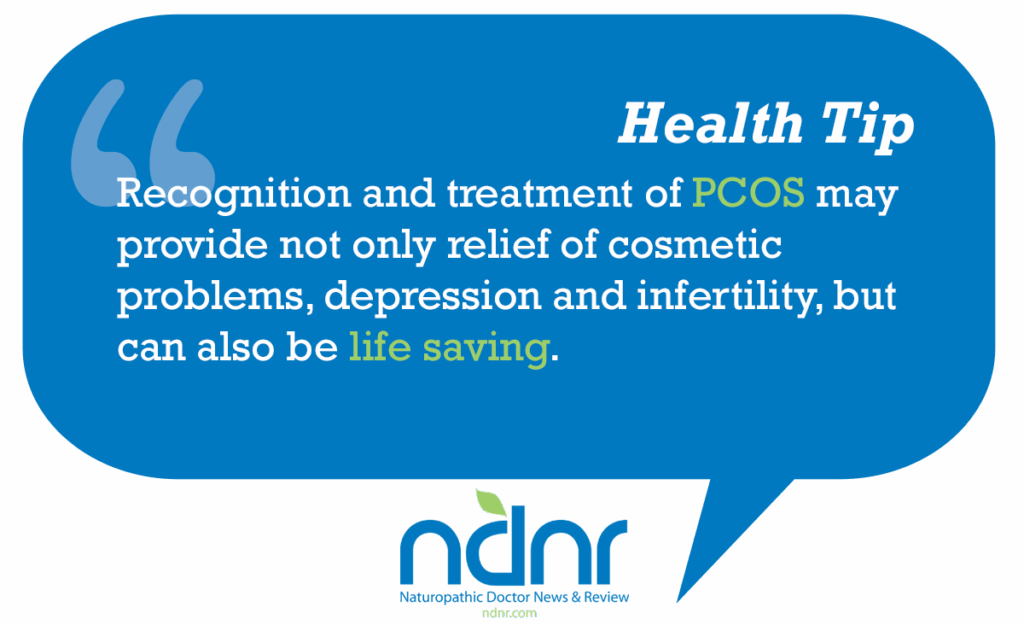Diagnosing the Underdiagnosed
Pamela Frank, BSc (Hons), ND
Polycystic ovary syndrome (PCOS) is a collection of symptoms caused by hyperandrogenism that affects 5%-10% of all women and often goes undiagnosed. 1 The hyperandrogenism of PCOS appears to be due to dysregulation of steroidogenesis within the ovaries and adrenal glands. The key enzyme that regulates androgen synthesis is P450c17.2 The insulin/insulin-like growth factor (IGF) system stimulates P450c17 mRNA expression and activities in the ovaries and adrenal glands.2
There is evidence for a genetic component in PCOS based on clustering of the condition within families. The majority of the evidence supports an autosomal dominant form of inheritance.3 PCOS is associated with the metabolic syndrome and carries a greatly increased risk of impaired glucose tolerance, type 2 diabetes mellitus, and cardiovascular disease. Since PCOS is a blood sugar/insulin-related condition, as the incidence of diabetes rises so too will the incidence of PCOS. Recognition and treatment of PCOS may provide not only relief of cosmetic problems, depression and infertility, but can also be life saving.
Diagnosis
More than 50% of all patients with menstrual dysfunction have polycystic ovaries. Many of these women are frustrated by how difficult it is to get properly diagnosed with PCOS. Difficulty in diagnosing PCOS arises because:
- Birth control pills (BCP) mask the symptoms and interfere with accurate hormone blood testing.
- No one healthcare practitioner is addressing all of the symptoms of PCOS. For example, patients are referred to a dermatologist for acne and a gynecologist for irregular menstruation.
- PCOS women will take great measures to hide, and sometimes fail to disclose, symptoms of PCOS like acne, hair loss and excess facial hair.
- There is no one definitive test for PCOS; diagnosis is largely based on symptomatology. In 2003 a consensus workshop in Rotterdam indicated PCOS to be present if 2 out of the following 3 criteria are met4:
i. Oligo and/or anovulation
ii. Excess androgen activity (clinical and/or biochemical)
iii. Polycystic ovaries on ultrasound, after the exclusion of other endocrine disorders
Given the above definition it is important to screen every female patient for signs and symptoms of hyperandrogenism. The most relevant tests to order are: pelvic and transvaginal ultrasound, total testosterone and free testosterone, and DHEAS.
Tests
Pelvic and Transvaginal Ultrasound These tests are not definitive, but may show the classic “string of pearls”, or no cysts may be present. Polycystic ovarian morphology can be seen on ultrasound in up to 22% of women.1 Criteria for ultrasound definition of polycystic ovaries (PCO): increased ovarian area (>5.5 cm2) or volume (>11 mL) and/or presence of 12 follicles measuring 2-9 mm in diameter (mean of both ovaries).5 These criteria had a specificity of 99% and a sensitivity of 75% for the diagnosis of PCOS.
Hormone Blood Tests
Normal ranges vary from one lab to another and units of measurement also vary. It’s best to go by the normal range set by the lab doing your testing.
- Fasting blood glucose – fasting or glucose tolerance test may be elevated. PCOS women with an abnormal glucose tolerance test will be significantly more obese, hyperandrogenic, and insulin resistant than those with PCOS and normal glucose tolerance.6
- Fasting insulin – may be elevated.
- Glucose tolerance test with insulin – helpful to diagnose insulin resistance. A hypoglycemic response in which the 2-hour insulin level is higher and the blood sugar lower than fasting is consistent with insulin resistance. A mathematical derivation known as the HOMA-IR, calculated from the fasting values in glucose and insulin concentrations, allows a direct and moderately accurate measure of insulin sensitivity (glucose-level x insulin-level/22.5). HOMA-IR is a simple, practical and sensitive index for assessing ovulation failure. After insulin-sensitizing treatment, HOMAIR is also a reliable and simple method for assessing recovery of ovulation function.7 Insulin resistance is found in 70% of women with PCOS.
- HbA1C (glycosylated hemoglobin) – may be elevated.
- Estradiol – may be normal or high.
- 17alpha-OH-progesterone (luteal phase) – low in anovulatory cycles in PCOS.
- LH – often higher than normal prior to ovulation in PCOS.
- FSH – had been thought useful to look at ratio of LH:FSH before ovulation, should be about 1:1. In PCOS maybe as high as 3:1, now considered of limited use in the diagnosis of PCOS.8
- AMH (Anti-Mullerian hormone) – Anti-Mullerian hormone levels can reflect the severity of PCOS but are negatively influenced by obesity.9
- Testosterone – free and total – often elevated in PCOS; even a slight increase can interfere with normal ovulation. Eighty percent of PCOS women are found to be hyperandrogenemic.10
- DHEAS – elevated in about 20% of Caucasian women and about 30% of African American women with PCOS,11 most will have either high normal or high levels.
- Prolactin – may be elevated, high levels can cause PCOS-type symptoms; pituitary tumor needs to be ruled out. Elevated prolactin levels are associated with a lower mean serum testosterone concentration and smaller ovaries.12
- Androstenedione – may be elevated.7
- If hair loss is a predominant symptom, also evaluate DHT, ferritin, TSH, T3, T4, rT3.
- Urinary 17-ketosteroids – used to evaluate adrenal gland function, may be elevated in PCOS.
- Sex hormone binding globulin (SHBG) – may be low.
- Lipid profile – there may be low HDL, high LDL, and elevated cholesterol and/or triglycerides.
- 25-OH-vitamin D – low serum concentrations may result from the presence of obesity and insulin resistance.13
- 24-hour urine free cortisol – to rule out Cushing’s syndrome. Hormone blood tests are not definitive as “normal” ranges are generally broad. One conventional laboratory recommends discarding the top and bottom third of the normal range and taking the middle third to determine what is optimal. Also, hormone levels fluctuate day to day and even throughout the day, so on any given day patients may not show an abnormal level for a particular hormone. The activity of hormones varies too, so while the blood level might be normal, the activity of testosterone may be elevated if SHBG is low. And lastly, hormone blood tests are completely useless if drawn while taking BCPs, as the pill will mask underlying hormonal imbalances like elevated testosterone and low progesterone
Signs and Symptoms
More important than testing are the symptoms of PCOS. Signs and symptoms associated with PCOS:
- Irregular periods – completely absent periods, infrequent periods, or oligomenorrhea (cycles of greater than 35 days). Note: 20% of women with PCOS may have regular periods.3 Regular periods do not preclude an underlying androgen excess disorder.14
- Hirsutism – coarse hair on a woman in a male pattern (upper lip, chin, chest, upper abdomen, back, etc). A Dec 2004 study showed that women with even minimal excess hair should have their hormone levels evaluated.14 Hirsutism is associated with a higher mean serum testosterone concentration compared with those PCOS patients who are unaffected.12
- Anovulation or irregular ovulation – women with PCOS produce follicles, but they often do not mature and release as needed for ovulation; these immature follicles are the cysts that may be seen on ultrasound.
- Head hair loss – women with some markers of insulin resistance have significantly increased risk for female androgenic alopecia.15 Alopecia is associated with lower mean serum LH and testosterone concentrations than in PCOS with alopecia.12
- Acne – may be on the face, chest, back and/or scalp.
- Infertility – difficulty getting pregnant (trying unsuccessfully to conceive for greater than 12 months) or inability to carry a pregnancy to term. Infertility is associated with higher mean serum gonadotrophin concentrations than in PCOS patients who are unaffected.12
- Hypoglycemia – symptoms include irritability, headaches, or light-headedness if meals are delayed and craving sweets or carbs.
- Hyperglycemia – symptoms include excessive thirst, frequent urination, and recurrent infections, especially recurrent yeast infections.
- Oily skin.
- Oily hair.
- Pelvic pain.
- Heavy, painful periods.
- Overweight, obese or difficulty losing weight (although up to 50% of PCOS women are normal weight or thin) – Obesity is associated with a higher mean serum testosterone concentration.12
- Acanthosis nigricans – dark patches of skin, tan to dark brown/black. Most commonly on the back of the neck, but also in skin creases under arms, breasts, and between thighs, occasionally on the hands, elbows and knees. The darkened skin is usually velvety or rough to the touch. Acanthosis nigricans is associated with obesity and a raised serum testosterone level.12
- Family history of diabetes.
- Non-alcoholic fatty liver disease.
With so many possible symptoms you can imagine that there may be many permutations and combinations. Not all of these symptoms need to be present and not having one or many of them present does not exclude a diagnosis of PCOS.
Important Questions to Ask on Intake
- Did your mother have gestational diabetes? Daughters of women who had gestational diabetes have a greater risk of PCOS. Women with PCOS also have a higher risk of gestational diabetes during pregnancy.
- Is there any family history of diabetes? Because PCOS is an insulin-related disorder, there is often a family history of type 2 diabetes mellitus.
- Have you ever had problems with acne? Have you ever had acne treatments such as isotretinoin, BCPs, or antibiotics? Don’t assume a patient with clear skin doesn’t have an underlying acne problem. Acne in women beyond puberty is usually androgen-excess related.
- Have your periods ever been irregular? Many women are on birth control pills and have been since their teen years and therefore will never know.
- Do you have any problems with hair loss or excess hair growth on your face or body? Again, don’t assume because the patient in front of you is smooth skinned that she doesn’t have hirsutism problems. She probably takes measures to address any excess hair. She may not disclose this information even if asked.
- Do you have a history of infertility or miscarriages?
Differential Diagnoses
Pregnancy, congenital adrenal hyperplasia, Cushing’s syndrome, thyroid disease, hyperprolactinemia, androgen-secreting neoplasms, and other pituitary or adrenal disorders should be investigated. PCOS has been reported in other insulin-resistant situations such as acromegaly.
As naturopathic doctors we are uniquely suited to diagnose and treat PCOS. Our thorough, holistic intake allows us to put the pieces of the puzzle together for patients whose health care has thus far been very fragmented and frustrating.
 Pamela Frank, BSc (Hons), ND has 10 years of experience as an ND and 20 years as a medical laboratory technologist. She is Clinic Director of Forces of Nature Wellness in Toronto and was twice voted “Best Naturopath in Toronto”. Pamela maintains a busy, diverse practice with particular expertise in naturopathic treatment of PCOS, PMS, menopause, acne, infertility, uterine fibroids and endometriosis. Pamela’s interests include fitness, triathlons, yoga, healthy cooking, tennis and volleyball.
Pamela Frank, BSc (Hons), ND has 10 years of experience as an ND and 20 years as a medical laboratory technologist. She is Clinic Director of Forces of Nature Wellness in Toronto and was twice voted “Best Naturopath in Toronto”. Pamela maintains a busy, diverse practice with particular expertise in naturopathic treatment of PCOS, PMS, menopause, acne, infertility, uterine fibroids and endometriosis. Pamela’s interests include fitness, triathlons, yoga, healthy cooking, tennis and volleyball.
References
1. Hart R, Hickey M, Franks S. Definitions, prevalence and symptoms of polycystic ovaries and polycystic ovary syndrome. Best Pract Res Clin Obstet Gynaecol. 2004;18(5):671-683.
2. Qin KN, Rosenfield RL. Role of cytochrome P450c17 in polycystic ovary syndrome. Mol Cell Endocrinol. 1998;145(1-2):111-121.
3. Amato P, Simpson JL. The genetics of polycystic ovary syndrome. Best Pract Res Clin Obstet Gynaecol. 2004;18(5)707-718.
4. The Rotterdam ESHRE/ASRM—Sponsored PCOS Consensus Workshop Group. (2004) Revised 2003 consensus on diagnostic criteria and long-term health risks related to polycystic ovary syndrome. Fertil Steril. 81:19–25.
5. Jonard S, Robert Y, Cortet-Rudelli C, et al. Ultrasound examination of polycystic ovaries: is it worth counting the follicles? Hum Reprod. 2003;18(3):598–603.
6. Bhattacharya SM. Polycystic ovary syndrome and abnormalities in glucose tolerance. Int J Gynaecol Obstet. 2009;105(1):29-31.
7. Ma F, Qiao L, Yue H, et al. Homeostasis model assessmentinsulin resistance (HOMA-IR), a key role for assessing the ovulation function in polycystic ovary syndrome (PCOS) patients with insulin resistance. Endocr J. 2008;55(5):943-945.
8. Cho LW, Jayagopal V, Kilpatrick ES, et al. The LH/FSH ratio has little use in diagnosing polycystic ovarian syndrome. Ann Clin Biochem. 2006;43(pt 3):217-219.
9. Piouka A, Farmakiotis D, Katsikis I, et al. Anti-Mullerian hormone levels reflect severity of PCOS but are negatively influenced by obesity: relationship with increased luteinizing hormone levels. Am J Physiol Endocrinol Metab. 2009;296(2):E238-E243.
10. Moran C, Renteria JL, Moran S, et al. Obesity differentially affects serum levels of androstenedione and testosterone in polycystic ovary syndrome. Fertil Steril. 2008;90(6):2310-2307.
11. Kumar A, Woods KS, Bartolucci AA, Azziz R. Prevalence of adrenal androgen excess in patients with the polycystic ovary syndrome (PCOS). Clin Endocrinol (Oxf). 2005;62(6):644-649.
12. Conway GS, Honour JW, Jacobs HS. Heterogeneity of the polycystic ovary syndrome: clinical, endocrine and ultrasound features in 556 patients. Clin Endocrinol (Oxf). 1989;30(4):459–470.
13. Yildizhan R, Kurdoglu M, Adali E, et al. Serum 25-hydroxyvitamin D concentrations in obese and nonobese women with polycystic ovary syndrome. Arch Gynecol Obstet. 2009;280(4):559-563.
14. Souter I, Sanchez LA, Perez M, et al. The prevalence of androgen excess among patients with minimal unwanted hair growth. Am J Obstet Gynecol. 2004;191(6):1914-1920.
15. Matilainen V, Laakso M, Hirsso P, et al. Hair loss, insulin resistance, and heredity in middle-aged women. A population-based study. J Cardiovasc Risk. 2003;10(3):227-231.








